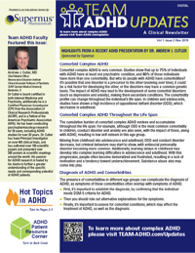
Andrew J. Cutler, MD
Associate clinical professor, Department of Psychiatry, SUNY Upstate Medical University, Syracuse, NY
Dr. Cutler is the chief medical officer at Neuroscience Education Institute in Carlsbad, CA, and a clinical associate professor of psychiatry at SUNY Upstate Medical University in Syracuse, NY. He works remotely from Lakewood Ranch, FL.
Common Comorbidities in Comorbid Complex ADHD: Prevalence, Age of Onset, Diagnosis, and Clinical Implications
Dr. Cutler, associate clinical professor in the Department of Psychiatry, SUNY Upstate Medical University in Syracuse, NY, discusses comorbid complex ADHD—prevalence, age of onset, diagnosis and clinical implications.
Hello, I'm Dr. Andrew Cutler, associate clinical professor in the Department of Psychiatry, SUNY Upstate Medical University in Syracuse, New York. And I'm pleased to be discussing comorbid complex ADHD – prevalence, age of onset, diagnosis, and clinical implications.
Comorbid complex ADHD is very common — studies show that three- quarters of individuals with ADHD have at least one psychiatric condition, and 80% of those have more than one comorbidity.1
But why do people with ADHD have comorbidities? It’s possible that one disorder is a precursor to the other (evolving over time), it could be a risk factor for developing the other, or they may have a common genetic basis. Some comorbid disorders (such as depression and anxiety) may develop due to the impact of ADHD, making it a secondary condition.2,3
The comorbidity profile can change throughout the lifespan. In children and adolescents, studies have shown a high incidence of oppositional defiant disorder, which decreases in adulthood. However, in adults, we see problems with emotional dysregulation, stubbornness, trouble managing anger, and other negative emotions. In addition, those comorbidities that tend to be less common in childhood, such as conduct issues, anxiety, major depressive disorder, and substance use disorder, increase in incidence through adolescence, and into adulthood.
The cumulative burden of comorbid complex ADHD evolves and accumulates throughout the lifespan. For example, although oppositional defiant disorder is the most common comorbidity in children, conduct disorder and anxiety are also seen, with the impact of these, along with ADHD, resulting in low self-esteem in this age group. Moving from childhood into adolescence and adulthood, oppositional defiant disorder and conduct disorder decrease, but criminal behaviors start to show, with antisocial personality disorder becoming more common. In addition, learning delays in childhood develop into complex learning difficulties in adolescence and adulthood. With this progression, people often become demoralized and frustrated, resulting in lack of motivation and under achievement. Substance abuse comes into play as well.2,4-8
The presence of comorbidities in different age groups can complicate the diagnosis of ADHD, as symptoms of these comorbidities often overlap with symptoms of ADHD. For example, ADHD symptoms of restlessness, agitation, difficulty concentrating, and decreased attention are also seen in major depressive disorder, bipolar disorder, anxiety, substance use disorder, and sleep disorders; and the ADHD symptom of impulsivity [activate slide build] is also seen in conduct disorder, bipolar disorder, and substance use disorder.2,9
So, given the overlap of symptoms of ADHD and its comorbidities, what are the steps to ensure an accurate diagnosis? First, it's important to establish the diagnosis, by confirming that the individual meets DSM-5 criteria for ADHD. Then, you should rule out alternative explanations for the symptoms. Finally, and as we've already talked about, it's important to assess for comorbid conditions, which may affect the treatment of ADHD, as well as the diagnosis.10
For example, to differentiate ADHD from depression, it is necessary to identify which symptoms of depression overlap with ADHD and which are distinct. Overlapping symptoms include loss of motivation, problems concentrating, and restlessness or irritability. So, if your patient has any of these symptoms, it could be ADHD, depression, or both. However, if your patient has only symptoms of depression that are distinct from ADHD, such as feelings of sadness, thoughts of suicide, or changes in eating or sleeping, it is likely depression.2
Thank you for being part of this Team ADHD educational presentation.
REFERENCES: 1.Banaschewski T, et al. Attention- Deficit/Hyperactivity Disorder. Dtsch Arztebl Int. 2017;114(9):149-159. 2.CADDRA Canadian ADHD Practice Guidelines 2018. https://www.caddra.ca/wp- content/uploads/CADDRA-Guidelines-4th- Edition_-Feb2018.pdf 3.Pliszka SR. Comorbidity of ADHD with psychiatric disorder: an overview. J Clin Psychiatry. 1998;59:50-58. 4.Turgay A, Ansari R. Major depression with ADHD in children and adolescents. Psychiatry. 2006;3(4)20-37. 5.Goodman DW. ADHD in adults: update for clinicians on diagnosis and assessment. Primary Psychiatry. 2009;16(11):21-30. 6. Faraone SV et al. Attention- deficit/hyperactivity disorder. Nat Rev Dis Primers. 2015;1:1-23. 7.Harpin VA. The effect of ADHD on the life of an individual, their family, and community from preschool to adult life. Arch Dis Child. 2005;90(Suppl I):i2–i7. 8. Biederman J, et al. Adult outcome of ADHD: a controlled 16-year follow up study. J Clin Psychiatry. 2012;73(7):941- 950. 9.Kooij S, et al. Distinguishing comorbidity and successful management of adult ADHD. J Atten Disord. 2012;16:3S-19S. 1. 10. American Academy of Pediatrics. ADHD: Clinical Practice Guideline for the Diagnosis, Evaluation, and Treatment of Attention-Deficit/Hyperactivity Disorder in Children and Adolescents Pediatrics. 2011;128:1007–1022.

TEAM ADHD Updates: Comorbid Complex ADHD Featuring Andrew J. Cutler, MD
UP NEXT:

